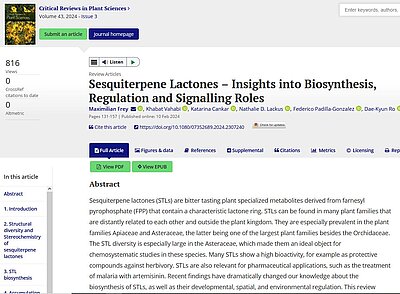Sesquiterpene lactones: A comprehensive review of fascinating natural products.
IPB scientists, together with Dutch and Canadian partners, have recently published a review on sesquiterpene lactones (STLs), in which they discuss in detail the biosynthesis, regulation and signaling function of these special natural products. Sesquiterpene lactones are mostly bitter-tasting phytochemicals with a 15-carbon backbone, characterized by their distinctive lactone ring. Approximately 5000 STLs are known to date, most of which are found in Asteraceae. The great structural diversity of STLs makes them an ideal target for chemosystematic and ecological studies. Many STLs are biologically active. They have antibiotic, antitumor, and anti-inflammatory properties. In plants, STLs act primarily as defense substances against herbivores and microorganisms. In humans, this group of substances is increasingly becoming the focus of pharmaceutical development due to their diverse effects. For example, the antimalarial drug artemisinin from mugwort (Artemisia annua) belongs to the group of sesquiterpene lactones.
In recent years, the amount of data on STL structures, biosynthetic genes, transcriptome and genome sequences of STL-producing plants, as well as on the biological activities of the compounds investigated, has increased considerably. In their review, the authors highlight some important aspects that have not yet been reported in detail. In particular, they discuss STL biosynthesis, covering not only the pure metabolic pathways but also compiling a large amount of knowledge on the enzymes involved and their regulation. Storage of STLs, which due to their biological activity are often accumulated in special organs such as oil bodies, resin ducts, glandular trichomes, and laticifers, is also treated in detail. Finally, the scientists offer a look into the not-too-distant future regarding the great possibilities of genome editing in this field and the resulting knowledge gain for plant research. A deeper knowledge of STL biosynthesis regulation, compartmentalization, and evolution will contribute to a better understanding of other substance classes of plant secondary metabolism, the authors conclude.


